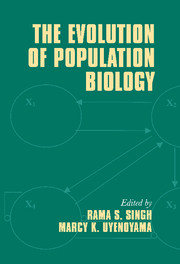Book contents
- Frontmatter
- Contents
- List of contributors
- Publications of R. C. Lewontin
- Preface
- Introduction
- Part I Historical foundations and perspectives
- Part II Genotypes to phenotypes: new genetic and bioinformatic advances
- Part III Phenotypes to fitness: genetics and ecology of populations
- 7 Density-dependent selection
- 8 Nonsynonymous polymorphisms and frequency-dependent selection
- 9 Why k = 4Nus is silly
- 10 Inferences about the structure and history of populations: coalescents and intraspecific phylogeography
- 11 The population genetics of life-history evolution
- 12 Gene–environment complexities: what is interesting to measure and to model?
- 13 Genus–specific diversification of mating types
- Part IV Genes, organisms, and environment: evolutionary case studies
- Part V Applied population biology: biodiversity and food, disease, and health
- Index
11 - The population genetics of life-history evolution
Published online by Cambridge University Press: 08 January 2010
- Frontmatter
- Contents
- List of contributors
- Publications of R. C. Lewontin
- Preface
- Introduction
- Part I Historical foundations and perspectives
- Part II Genotypes to phenotypes: new genetic and bioinformatic advances
- Part III Phenotypes to fitness: genetics and ecology of populations
- 7 Density-dependent selection
- 8 Nonsynonymous polymorphisms and frequency-dependent selection
- 9 Why k = 4Nus is silly
- 10 Inferences about the structure and history of populations: coalescents and intraspecific phylogeography
- 11 The population genetics of life-history evolution
- 12 Gene–environment complexities: what is interesting to measure and to model?
- 13 Genus–specific diversification of mating types
- Part IV Genes, organisms, and environment: evolutionary case studies
- Part V Applied population biology: biodiversity and food, disease, and health
- Index
Summary
Introduction
The subject of this chapter is how natural selection acts on age-structured populations, in which age-specific patterns of survival probabilities and reproductive rates are the fundamental parameters describing the life history of a genotype. This is a large subject, and the chapter does not offer a comprehensive review. Instead, I will concentrate on some aspects on which I myself have worked. My interest in the subject was stimulated as a beginning postdoc in Dick Lewontin's laboratory, over 30 years ago, when he and Tim Prout expressed some well-justified skepticism about the logical basis of the use of Fisher's “Malthusian parameters” (Fisher 1930, Chapter 2) for modeling selection in populations with overlapping generations (Charlesworth 1970). I have contributed, somewhat fitfully, to this subject during much of my subsequent career.
The fundamental problem is how to describe selection in the context of a population divided into different age groups. This provides the basis for asking the more exciting question of how to understand the evolution of life histories, which will be briefly discussed at the end of this chapter. Dick Lewontin was, of course, one of the pioneers of theoretical work on life-history evolution (Lewontin 1965); his paper, together with Hamilton's seminal paper on the evolution of senescence (Hamilton 1966), motivated me to pursue further work on selection with age structure.
- Type
- Chapter
- Information
- The Evolution of Population Biology , pp. 216 - 232Publisher: Cambridge University PressPrint publication year: 2004



